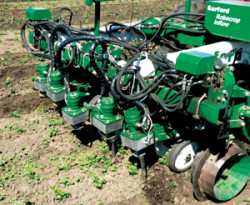Success Of The RoboCrop Weeder, Thinner

At a recent meeting in Salinas, CA, Dr. Steve Fennimore, a University of California (UC) Cooperative Extension Service weed specialist, presented preliminary data that he and other UC staff had collected in a series of trials using the RoboCrop Weeder/Thinner. Dr. Fennimore leads a research project to evaluate the Garford RoboCrop Weeder/Thinner in lettuce, celery, and fresh market tomatoes.
The exciting thing about the RoboCrop unit is that it is commercially available as opposed to other machines that are under development by university researchers or private companies and are still some time away from being available to vegetable growers.
The RoboCrop unit can be set up as a crop thinner or in-the-row weeder. It uses a camera to detect the plants and sense their location. This information is fed to a computer, which can be programmed to operate the machine as an automatic crop thinner or an in-row weeder. The machine has a control screen that shows what the camera is seeing. This also allows the operator to see the information that the machine is using to control either the weeding or thinning function.
When in thinning mode, a hydraulically powered, rotating notched disc is used to remove the excess plants. In the weeding mode, the disc moves down the row between the crop plants, removing weeds and then revolving around the plants without damaging them.
Unit Uses
In lettuce, the machine was used to thin and weed. In celery and tomatoes, it was used as a weeder. During a thinning trial in lettuce, it took the hand crew 11.6 hours per acre to complete the task while the RoboCrop took 4.2 hours per acre. After thinning, plant populations were 28,000 per acre for the hand crew and 31,000 plants per acre for the RoboCrop thinned area.
In three trials, RoboCrop-thinned lettuce plots were carried to harvest. Lettuce head size in terms of weight per head was slightly larger in two trials. In one trial, head size was slightly less in the machine-thinned plots.
For fresh market tomatoes where the RoboCrop was used as a weeder, yields were essentially the same as in the hand-weeded plot. For celery weeding, there was no significant difference in the final stand between the hand-weeded and RoboCrop-weeded plots.
Although this is just initial data, it certainly indicates that a RoboCrop operated by one person can successfully reduce labor needs for thinning and weeding vegetable crops.
The RoboCrop was on display in the Solex Corporation booth at World Ag Expo in Tulare, CA. Solex is the U.S. distributor for the RoboCrop machine, which is made in England.









